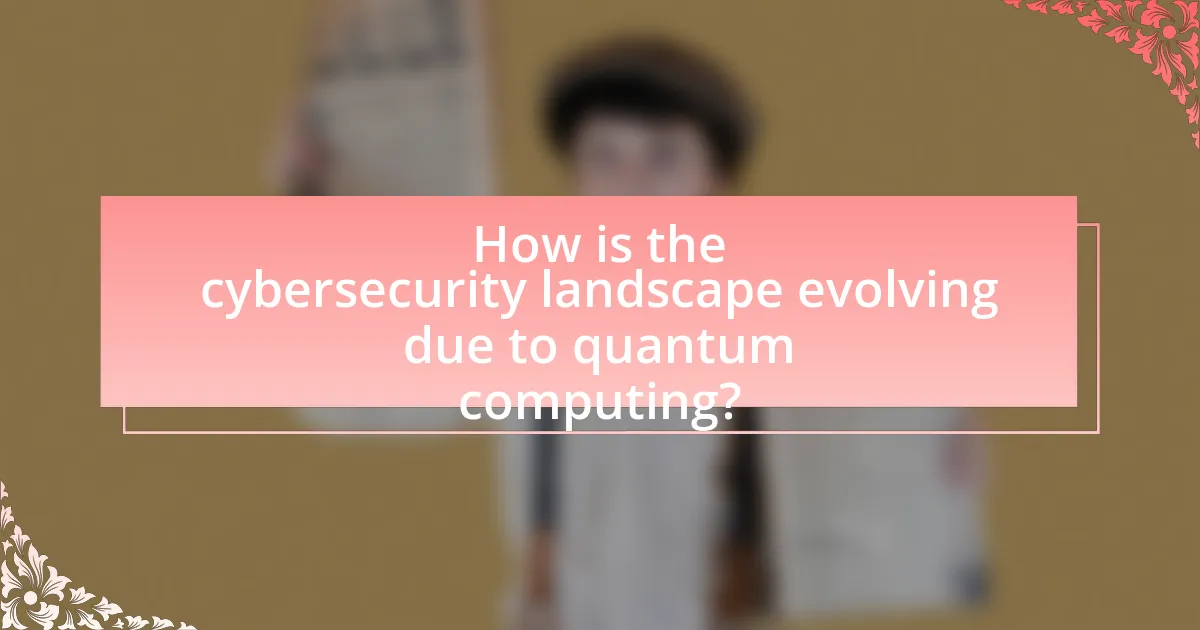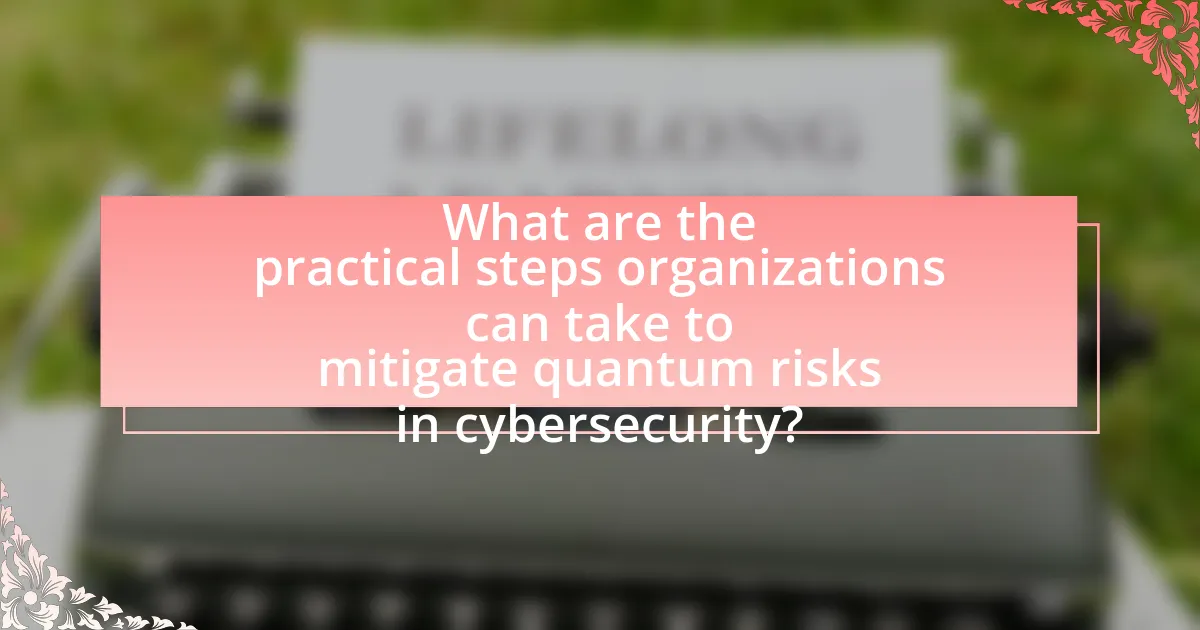The article examines the impact of quantum computing on cybersecurity, highlighting the potential threats it poses to traditional encryption methods such as RSA and ECC. Quantum computers can efficiently solve complex mathematical problems that underpin these encryption techniques, rendering them vulnerable and necessitating the development of quantum-resistant cryptographic algorithms. Key principles of quantum computing, including superposition and entanglement, are discussed in relation to their implications for data integrity and confidentiality. The article also explores current trends in quantum cybersecurity, the regulatory challenges arising from quantum advancements, and practical steps organizations can take to mitigate risks associated with quantum threats.

What is the Impact of Quantum Computing on Cybersecurity?
Quantum computing poses a significant threat to cybersecurity by potentially breaking widely used encryption methods. Traditional encryption algorithms, such as RSA and ECC, rely on the difficulty of factoring large numbers or solving discrete logarithm problems, which quantum computers can solve efficiently using algorithms like Shor’s algorithm. This capability could render current encryption standards obsolete, exposing sensitive data to unauthorized access. Research indicates that quantum computers could break RSA encryption in a matter of hours, highlighting the urgency for developing quantum-resistant cryptographic methods to safeguard information in a post-quantum world.
How does quantum computing differ from classical computing in cybersecurity?
Quantum computing fundamentally differs from classical computing in cybersecurity by its ability to solve complex mathematical problems exponentially faster, which poses a significant threat to traditional encryption methods. Classical computing relies on algorithms that can take an impractical amount of time to break encryption, such as RSA, which is based on the difficulty of factoring large prime numbers. In contrast, quantum computers utilize algorithms like Shor’s algorithm, which can factor these numbers in polynomial time, effectively rendering classical encryption methods vulnerable. This capability has been demonstrated in theoretical studies, indicating that quantum computers could break widely used encryption standards, necessitating the development of quantum-resistant cryptographic techniques to safeguard sensitive information.
What are the fundamental principles of quantum computing relevant to cybersecurity?
The fundamental principles of quantum computing relevant to cybersecurity include superposition, entanglement, and quantum measurement. Superposition allows quantum bits (qubits) to exist in multiple states simultaneously, which can exponentially increase computational power compared to classical bits. Entanglement creates a strong correlation between qubits, enabling secure communication channels through quantum key distribution (QKD), which ensures that any eavesdropping can be detected. Quantum measurement collapses the superposition of qubits into a definite state, impacting the security of cryptographic systems that rely on the difficulty of certain mathematical problems, such as factoring large integers. These principles highlight the potential for quantum computing to break traditional encryption methods, necessitating the development of quantum-resistant algorithms to safeguard sensitive information.
How does quantum computing challenge traditional cybersecurity measures?
Quantum computing challenges traditional cybersecurity measures primarily by its ability to efficiently solve problems that are currently intractable for classical computers, particularly in the realm of cryptography. For instance, quantum algorithms like Shor’s algorithm can factor large integers exponentially faster than the best-known classical algorithms, which undermines the security of widely used encryption methods such as RSA and ECC. This capability poses a significant threat to data confidentiality and integrity, as sensitive information protected by these encryption standards could be decrypted in a feasible timeframe. The National Institute of Standards and Technology (NIST) has acknowledged this risk and is actively working on post-quantum cryptography standards to address the vulnerabilities introduced by quantum computing.
What potential threats does quantum computing pose to current cybersecurity practices?
Quantum computing poses significant threats to current cybersecurity practices primarily by undermining the cryptographic algorithms that secure data. Traditional encryption methods, such as RSA and ECC, rely on the difficulty of factoring large numbers or solving discrete logarithm problems, which quantum computers can efficiently solve using algorithms like Shor’s algorithm. This capability means that sensitive information encrypted with these methods could be decrypted in a fraction of the time it currently takes, rendering existing security measures ineffective. As a result, organizations must transition to quantum-resistant algorithms to safeguard their data against potential breaches facilitated by quantum computing advancements.
How can quantum computing break existing encryption methods?
Quantum computing can break existing encryption methods primarily through its ability to efficiently solve mathematical problems that underpin these encryption techniques. For instance, Shor’s algorithm allows quantum computers to factor large integers exponentially faster than classical computers, which directly threatens RSA encryption, widely used for secure data transmission. Classical algorithms would take an impractical amount of time to factor a 2048-bit RSA key, while a sufficiently powerful quantum computer could achieve this in a matter of hours or even minutes. This capability fundamentally undermines the security of systems relying on RSA and similar encryption methods, as the confidentiality of encrypted data would be compromised.
What are the implications of quantum attacks on data integrity and confidentiality?
Quantum attacks pose significant threats to data integrity and confidentiality by exploiting the principles of quantum computing to break traditional cryptographic algorithms. These attacks can compromise the security of sensitive information, as quantum computers can efficiently solve problems that are currently infeasible for classical computers, such as factoring large integers and computing discrete logarithms. For instance, Shor’s algorithm enables a quantum computer to factor a 2048-bit RSA key in polynomial time, rendering RSA encryption obsolete. This vulnerability undermines data integrity by allowing unauthorized access and manipulation of data, while also jeopardizing confidentiality by exposing sensitive information to adversaries. The implications extend to various sectors, including finance, healthcare, and national security, where the protection of data is paramount.
What opportunities does quantum computing present for enhancing cybersecurity?
Quantum computing presents significant opportunities for enhancing cybersecurity by enabling the development of advanced cryptographic techniques that are resistant to quantum attacks. For instance, quantum key distribution (QKD) utilizes the principles of quantum mechanics to create secure communication channels, ensuring that any eavesdropping attempts can be detected immediately. Research has shown that QKD can provide theoretically unbreakable encryption, as demonstrated by experiments conducted by the University of Science and Technology of China, which successfully transmitted quantum keys over long distances. Additionally, quantum algorithms, such as Shor’s algorithm, highlight the need for post-quantum cryptography, prompting the development of new encryption methods that can withstand potential threats posed by quantum computers. This proactive approach to cybersecurity not only strengthens data protection but also fosters innovation in cryptographic practices.
How can quantum key distribution improve secure communications?
Quantum key distribution (QKD) can significantly improve secure communications by enabling the generation and sharing of cryptographic keys that are provably secure against eavesdropping. QKD utilizes the principles of quantum mechanics, specifically the behavior of quantum bits (qubits), to ensure that any attempt at interception can be detected. For instance, if an eavesdropper tries to measure the quantum states used in the key exchange, the act of measurement alters those states, alerting the communicating parties to the presence of the eavesdropper. This inherent security feature is backed by the no-cloning theorem, which states that it is impossible to create an identical copy of an arbitrary unknown quantum state. Thus, QKD provides a robust framework for secure communications that traditional methods cannot match, as it guarantees the confidentiality of the keys used for encryption.
What role does quantum computing play in developing new cryptographic algorithms?
Quantum computing significantly influences the development of new cryptographic algorithms by introducing capabilities that can break traditional encryption methods. Classical algorithms, such as RSA and ECC, rely on the difficulty of certain mathematical problems, like factoring large integers or solving discrete logarithms, which quantum computers can solve efficiently using algorithms like Shor’s algorithm. This capability necessitates the creation of quantum-resistant algorithms, known as post-quantum cryptography, which are designed to withstand potential quantum attacks. Research, such as the NIST Post-Quantum Cryptography Standardization project, aims to evaluate and standardize these new algorithms to ensure data security in a future where quantum computing is prevalent.

How is the cybersecurity landscape evolving due to quantum computing?
Quantum computing is fundamentally altering the cybersecurity landscape by introducing new vulnerabilities and necessitating the development of quantum-resistant cryptographic algorithms. Traditional encryption methods, such as RSA and ECC, rely on the difficulty of factoring large numbers or solving discrete logarithm problems, which quantum computers can efficiently solve using algorithms like Shor’s algorithm. This capability threatens the security of sensitive data, prompting organizations to explore post-quantum cryptography solutions that can withstand quantum attacks. Research from the National Institute of Standards and Technology (NIST) is actively guiding the transition to these new cryptographic standards, highlighting the urgency for businesses to adapt their security frameworks in anticipation of quantum advancements.
What are the current trends in quantum computing and cybersecurity integration?
Current trends in quantum computing and cybersecurity integration include the development of quantum-resistant cryptographic algorithms and the exploration of quantum key distribution (QKD) for secure communication. As quantum computers advance, traditional encryption methods, such as RSA and ECC, face vulnerabilities due to their ability to factor large numbers and solve discrete logarithm problems efficiently. Consequently, organizations are prioritizing the adoption of post-quantum cryptography standards, with the National Institute of Standards and Technology (NIST) actively working on standardizing quantum-resistant algorithms. Additionally, QKD is gaining traction as it leverages the principles of quantum mechanics to enable secure key exchange, making it theoretically immune to eavesdropping. These trends reflect a proactive approach to safeguarding sensitive information against the impending threats posed by quantum computing advancements.
How are organizations preparing for the quantum computing era in cybersecurity?
Organizations are preparing for the quantum computing era in cybersecurity by developing quantum-resistant encryption algorithms and investing in research to understand quantum threats. For instance, the National Institute of Standards and Technology (NIST) has been actively working on standardizing post-quantum cryptography, which aims to create cryptographic systems that can withstand quantum attacks. Additionally, many companies are conducting risk assessments to identify vulnerabilities in their current systems and are collaborating with academic institutions to advance quantum computing knowledge and its implications for cybersecurity. This proactive approach is essential as quantum computers have the potential to break widely used encryption methods, thus necessitating a shift in cybersecurity strategies.
What partnerships are forming between quantum computing and cybersecurity firms?
Partnerships are forming between quantum computing and cybersecurity firms to enhance data protection against quantum threats. For example, IBM has collaborated with various cybersecurity companies to develop quantum-safe encryption methods, ensuring that sensitive information remains secure in a post-quantum world. Additionally, startups like Qrypt are partnering with established cybersecurity firms to integrate quantum key distribution technologies, which provide a higher level of security by utilizing the principles of quantum mechanics. These collaborations are crucial as they aim to address the vulnerabilities that quantum computing poses to traditional encryption methods, thereby reinforcing the cybersecurity landscape.
What regulatory and compliance challenges arise from quantum computing in cybersecurity?
Quantum computing introduces significant regulatory and compliance challenges in cybersecurity due to its potential to break current encryption methods. Traditional encryption protocols, such as RSA and ECC, rely on mathematical problems that quantum computers can solve efficiently, undermining data protection and privacy regulations like GDPR and HIPAA. As organizations transition to quantum-resistant algorithms, they face the challenge of ensuring compliance with existing regulations while adapting to new technologies. Furthermore, the lack of established standards for quantum cybersecurity complicates regulatory oversight, creating uncertainty for businesses regarding compliance requirements. This situation necessitates the development of new frameworks and guidelines to address the unique risks posed by quantum computing in the cybersecurity landscape.
How are governments addressing the risks associated with quantum computing?
Governments are addressing the risks associated with quantum computing by developing national strategies and frameworks focused on quantum cybersecurity. For instance, the United States has initiated the National Quantum Initiative Act, which aims to advance quantum research and establish standards for quantum-safe cryptography. Similarly, the European Union has launched the Quantum Technologies Flagship program, investing €1 billion over ten years to enhance quantum research and its applications, including security measures. These initiatives are designed to mitigate potential threats posed by quantum computing to current encryption methods, ensuring that sensitive data remains secure as quantum technology evolves.
What standards are being developed for quantum-safe cybersecurity practices?
Standards for quantum-safe cybersecurity practices are being developed by organizations such as the National Institute of Standards and Technology (NIST) and the Internet Engineering Task Force (IETF). NIST is currently working on post-quantum cryptography standards, with the aim of selecting algorithms that can withstand quantum computing threats. In July 2022, NIST announced the finalization of four quantum-resistant algorithms for public key encryption and key establishment, which are expected to be integrated into cybersecurity protocols. The IETF is also collaborating on standards to ensure secure communication protocols are resilient against quantum attacks. These efforts are crucial as quantum computers have the potential to break widely used cryptographic systems, necessitating the establishment of robust, quantum-safe standards.

What are the practical steps organizations can take to mitigate quantum risks in cybersecurity?
Organizations can mitigate quantum risks in cybersecurity by adopting quantum-resistant cryptographic algorithms, implementing hybrid cryptographic systems, and conducting regular security assessments. Quantum-resistant algorithms, such as lattice-based or hash-based cryptography, are designed to withstand attacks from quantum computers, which can break traditional encryption methods. Hybrid systems combine classical and quantum-resistant algorithms to provide an additional layer of security during the transition period. Regular security assessments help organizations identify vulnerabilities and adapt their strategies to evolving quantum threats. These steps are crucial as the National Institute of Standards and Technology (NIST) has been actively working on standardizing post-quantum cryptography to prepare for the potential impact of quantum computing on data security.
How can businesses assess their vulnerability to quantum threats?
Businesses can assess their vulnerability to quantum threats by conducting a comprehensive risk assessment that includes evaluating their current encryption methods and identifying potential weaknesses. This involves analyzing the cryptographic algorithms in use, as many traditional encryption methods, such as RSA and ECC, are susceptible to quantum attacks, particularly from algorithms like Shor’s algorithm, which can efficiently factor large integers and compute discrete logarithms.
Furthermore, organizations should stay informed about advancements in quantum computing and quantum-safe cryptography, which is designed to withstand quantum attacks. Engaging with cybersecurity experts and utilizing tools that simulate quantum threat scenarios can also provide insights into vulnerabilities. Regularly updating security protocols and adopting quantum-resistant algorithms, such as lattice-based or hash-based cryptography, will enhance resilience against future quantum threats.
What tools and frameworks are available for quantum risk assessment?
Tools and frameworks available for quantum risk assessment include the Quantum Risk Assessment Framework (QRAF), which provides a structured approach to evaluate risks associated with quantum computing. Additionally, the Quantum Security Assessment Tool (QSAT) helps organizations assess their vulnerabilities to quantum threats. The National Institute of Standards and Technology (NIST) has also developed guidelines for post-quantum cryptography, which serve as a framework for assessing quantum-related risks. These tools and frameworks are essential for organizations to understand and mitigate the potential impacts of quantum computing on cybersecurity.
How can organizations prioritize their cybersecurity investments in light of quantum computing?
Organizations can prioritize their cybersecurity investments in light of quantum computing by focusing on post-quantum cryptography solutions. As quantum computers have the potential to break widely used encryption methods, organizations should assess their current cryptographic systems and transition to quantum-resistant algorithms. The National Institute of Standards and Technology (NIST) is actively working on standardizing post-quantum cryptographic algorithms, which provides a framework for organizations to follow. Investing in training for cybersecurity personnel on quantum threats and updating security protocols to include quantum resilience will further enhance their defenses against future quantum attacks.
What best practices should organizations adopt to prepare for quantum computing?
Organizations should adopt a proactive approach to prepare for quantum computing by implementing quantum-resistant cryptography. This involves transitioning from traditional cryptographic algorithms, which are vulnerable to quantum attacks, to quantum-safe algorithms that can withstand the computational power of quantum computers. For instance, the National Institute of Standards and Technology (NIST) is currently in the process of standardizing post-quantum cryptographic algorithms, which organizations should begin to integrate into their systems to ensure data security. Additionally, organizations should invest in training their IT staff on quantum computing concepts and potential threats, as well as collaborate with industry peers to share knowledge and best practices. This multifaceted strategy will help organizations mitigate risks associated with the advent of quantum computing in the cybersecurity landscape.
How can companies implement quantum-resistant encryption solutions?
Companies can implement quantum-resistant encryption solutions by adopting algorithms that are designed to withstand quantum attacks, such as lattice-based, hash-based, or code-based cryptography. These algorithms have been identified by the National Institute of Standards and Technology (NIST) as potential candidates for post-quantum cryptography, with NIST’s ongoing standardization process providing a framework for their implementation. By transitioning to these algorithms, companies can enhance their security posture against future quantum threats, ensuring that sensitive data remains protected as quantum computing technology advances.
What training and awareness programs are essential for cybersecurity teams regarding quantum threats?
Cybersecurity teams must undergo specialized training programs focused on quantum threat awareness and mitigation strategies. Essential programs include quantum cryptography training, which educates teams on the principles of quantum key distribution and its potential to secure communications against quantum attacks. Additionally, teams should participate in workshops that cover the implications of quantum computing on current encryption methods, emphasizing the need for transitioning to post-quantum cryptography standards.
Furthermore, continuous awareness programs that highlight emerging quantum technologies and their potential vulnerabilities are crucial. These programs should incorporate real-world case studies and simulations to illustrate the practical impacts of quantum threats on cybersecurity infrastructures. Research indicates that organizations that invest in such targeted training are better prepared to adapt to the evolving landscape of quantum computing and its implications for data security.
What resources are available for staying informed about quantum computing and cybersecurity?
Key resources for staying informed about quantum computing and cybersecurity include academic journals, online courses, and industry reports. Academic journals such as “Nature Quantum Information” and “IEEE Transactions on Quantum Engineering” publish peer-reviewed research that explores advancements in quantum technologies and their implications for cybersecurity. Online platforms like Coursera and edX offer courses from institutions like MIT and Stanford, covering both quantum computing fundamentals and cybersecurity measures. Additionally, organizations such as the National Institute of Standards and Technology (NIST) provide guidelines and updates on quantum-resistant cryptography, which is crucial for understanding the intersection of these fields.


